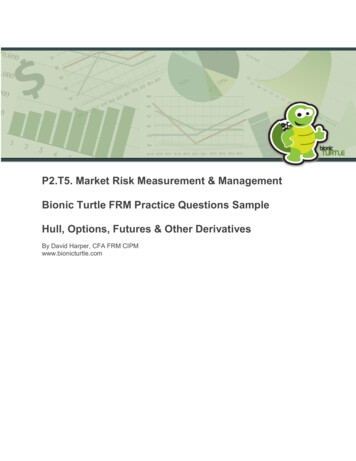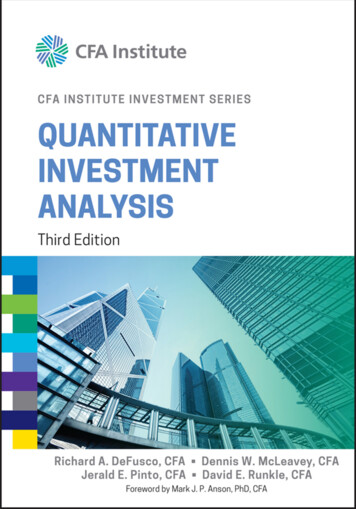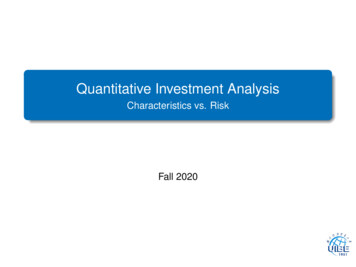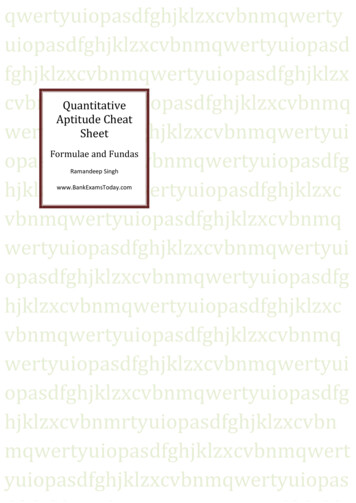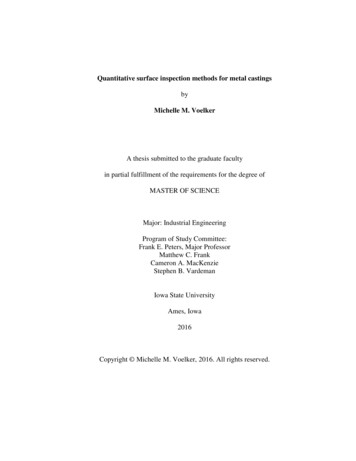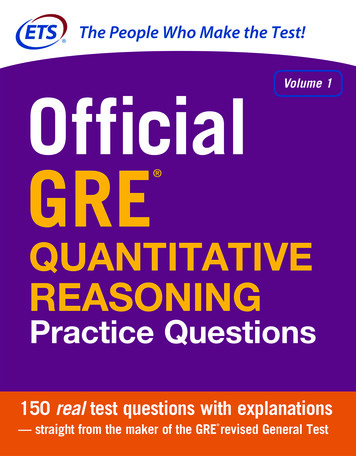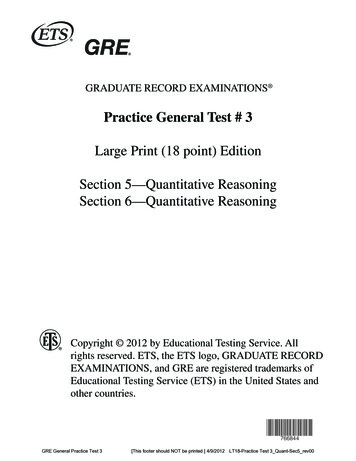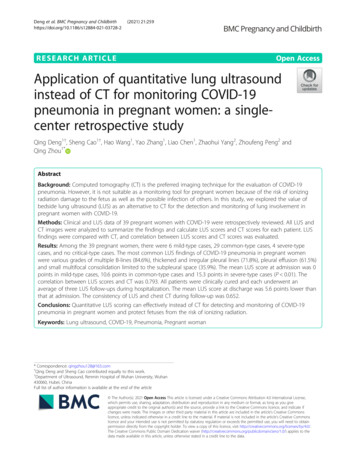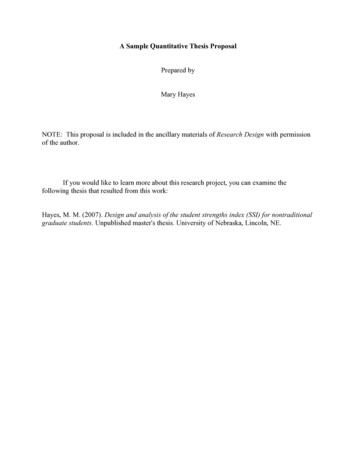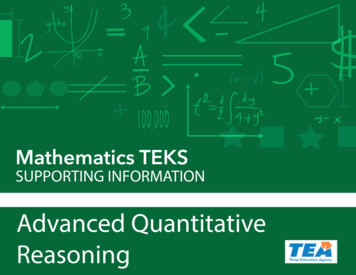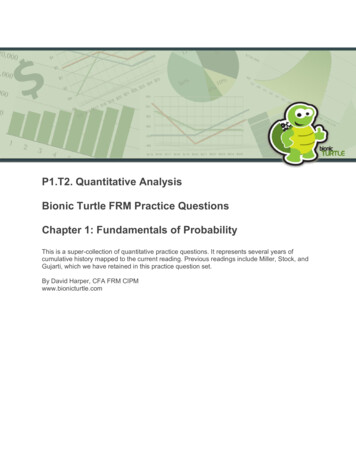
Transcription
P1.T2. Quantitative AnalysisBionic Turtle FRM Practice QuestionsChapter 1: Fundamentals of ProbabilityThis is a super-collection of quantitative practice questions. It represents several years ofcumulative history mapped to the current reading. Previous readings include Miller, Stock, andGujarti, which we have retained in this practice question set.By David Harper, CFA FRM CIPMwww.bionicturtle.com
Note that this pertains to Chapters 1-6 in Topic 2, Quantitative Analysis. We will includethis introduction in each of those practice question sets for reference.Within each chapter, our practice questions are sequenced in reverse chronological order(appearing first are the questions written most recently). For example, consider Miller’s Chapter2 (Probabilities), you will notice there are fully three (3) sets of questions: Questions T2.708 to 709 (Miller Chapter 2) were written in 2017. The 7XX denotes 2017.Questions T2.300 to 301 (Miller Chapter 2 were written in 2013. The 3XX denotes 2103.Questions T2.201 to 207 (Stock & Watson) were written in 2012. Relevant but optional.The reason we include the prior questions is simple: although the FRM’s econometrics readingshave churned in recent years (specifically, for Probabilities and Statistics, from Gujarati to Stockand Watson to Miller), the learning objectives (AIMs) have remain essentially unchanged.The testable concepts themselves, in this case, are generally quite durable over time.Therefore, do not feel obligated to review all of the questions in this document! Rather,consider the additional questions as merely a supplemental, optional resource for those who willto spend additional time with the concepts.The major sections are: This Chapter: Fundamentals of Probabilities (current QA-1, Chapter 1)o Most Recent BT questions, Miller Chapter 2 (T2.708 & T2.709)o Previous BT questions, Miller Chapter 2 (T2.300 to T2.301)o Previous BT questions, Stock & Watson Chapter 2 (T2.201 to T2.207) Random Variables (current QA-2, Chapter 2)o Most Recent BT questions, Miller Chapter 3 (T2.710 to T2.712)o Previous BT questions, Miller Chapter 3 (T2.303 to T2.308)o Previous BT questions, Stock & Watson Chapter 3 (T2.208 to T2.213)o Previous BT questions, Gujarati (T2.57 to T2.82) Common Univariate Random Variables (current QA-3, Chapter 3)o Most Recent BT questions, Miller Chapter 4 (T2.713 to T2.716)o Previous BT questions, Miller Chapter 4 (T2.309 to T2.312)o Previous BT questions, Rachev Chapters 2 & 3 (T2.110 to T2.126) Multivariate Random Variables (current QA-4, Chapter 4)o Most Recent BT questions Miller Ch.2 (T2.709) Miller Ch.3 (T2.711) Miller Ch.4 (T2.716)o Previous BT questions Miller Ch.2 (T2.301) Miller Chapter 3 (T2.304) Stock & Watson Chapter 2 (T2.201 to T2.202) Stock & Watson Chapter 3 (T2.212 to T2.213) Gujarati (T2.57, T2.58, T2.62, T2.64, T2.65 & T2.67)2
Sample Moments (current QA-5, Chapter 5)o Most Recent BT questions, Miller Chapter 3 (T2.710 to T2.712)o Previous BT questions, Miller Chapter 3 (T2.303 to T2.308)o Previous BT questions, Stock & Watson Chapter 3 (T2.212 & T2.213)o Previous BT questions, Gujarati (T2.62 to T2.78) Hypothesis Testing & Confidence Intervals (current QA-6, Chapter 6)o Most Recent BT questions, Miller Chapter 7 (T2.718 & T2.719)o Previous BT questions, Miller Chapter 5 (T2.313 – T2.315) Appendixo Annotated Gujarati (encompassing, highly relevant)3
PROBABILITIES - KEY IDEAS . 5Probabilities (Miller Chapter 2)P1.T2.708. PROBABILITY FUNCTION FUNDAMENTALS . 7P1.T2.709. JOINT PROBABILITY MATRICES .10P1.T2.300. PROBABILITY FUNCTIONS (MILLER) .13P1.T2.301. MILLER'S PROBABILITY MATRIX.16Probabilities (Stock & Watson Chapter 2)P1.T2.201. RANDOM VARIABLES .19P1.T2.202. VARIANCE OF SUM OF RANDOM VARIABLES .22P1.T2.203. SKEW AND KURTOSIS (STOCK & WATSON) .26P1.T2.204. JOINT, MARGINAL, AND CONDITIONAL PROBABILITY FUNCTIONS .28P1.T2.205. SAMPLING DISTRIBUTIONS (STOCK & WATSON) .30P1.T2.206. VARIANCE OF SAMPLE AVERAGE .32P1.T2.207. LAW OF LARGE NUMBERS AND CENTRAL LIMIT THEOREM (CLT) .34Appendix: Gujarati: Essentials of Econometrics, 3rd Edition ChaptersGUJARATI.02.12: .37GUJARATI.02.13: .38GUJARATI.03.08: .39GUJARATI.03.09: .40GUJARATI.03.10: .41GUJARATI.03.17: .42GUJARATI.03.21: .43GUJARATI.04.01: .44GUJARATI.04.03: .46GUJARATI.04.04: .47GUJARATI.04.06: .48GUJARATI.04.11: .48GUJARATI.04.15: .49GUJARATI.04.17: .50GUJARATI.04.18: .52GUJARATI.04.20: .53GUJARATI.05.01: .54GUJARATI.05.02: .56GUJARATI.05.03: .58GUJARATI.05.04: .60GUJARATI.05.09: .62GUJARATI.05.10: .63GUJARATI.05.13: .64GUJARATI.05.14: .65GUJARATI.05.17: .66GUJARATI.05.18: .67GUJARATI.05.19: .68GUJARATI.05.20: .694
Probabilities - Key Ideas Risk measurement is largely the quantification of uncertainty. We quantify uncertainty bycharacterizing outcomes with random variables. Random variables have distributionswhich are either discrete or continuous. In general, we observe samples; and use them to make inferences about a population(in practice, we tend to assume the population exists but it not available to us) We are concerned with the first four moments of a distribution:oMean, typically denoted µoVariance, the square of the standard deviation. Annualized standard deviation iscalled volatility; e.g., 12% volatility per annum. Variance is almost alwaysdenoted σ 2 and standard deviation by sigma, σoSkew (a function of the third moment about the mean): a symmetrical distributionhas zero skew or skewnessoKurtosis (a function of the fourth moment about the mean). The normal distribution has kurtosis 3.0 Excess kurtosis 3 – Kurtosis. The normal distribution, being thebenchmark, has excess kurtosis equal to zero Kurtosis 3.0 refers to a heavy-tailed distribution (a.k.a., leptokurtosis).Heavy-tailed distributions do tend to exhibit higher peaks, but ouremphasis in risk is their heavy tails. The concepts of joint, conditional and marginal probability are important. To test a hypothesis about a sample mean (i.e., is the true population mean differentthan some value), we use a student t or normal distributionoStudent t if the population variance is unknown (it usually is unknown)oIf the sample is large, the student t remains applicable, but as it approximates thenormal, for large samples the normal is used since the difference is not material To test a hypothesis about a sample variance, we use the chi-squared To test a joint hypothesis about regression coefficients, we use the F distribution In regard to the normal distribution:oN(mu, σ 2) indicates the only two parameters required. For example,N(3,10) connotes a normal distribution with mean of 3 and variance of 10 and,therefore, standard deviation of SQRT(10)oThe standard normal distribution is N(0,1) and therefore requires no parameterspecification: by definition it has mean of zero and variance of 1.0.oPlease memorize, with respect to the standard normal distribution: For N(0,1) Pr(Z -2.33) 1.0% (CDF is one-tailed) For N(0,1) Pr (Z -1.645) 5.0% (CDF is one-tailed)5
The definition of a random sample is technical: the draws (or trials) are independent andidentically distributed (i.i.d.)oIdentical: same distributionoIndependence: no correlation (in a time series, no autocorrelation)The assumption of i.i.d. is a precondition for:oLaw of large numbersoCentral limit theorem (CLT)oSquare root rule (SRR) for scaling volatility; e.g., we typically scales a dailyvolatility of (V) to an annual volatility with V*SQRT(250). Please note that i.i.d.returns is the unrealistic precondition.6
Probabilities (Miller Chapter 2)P1.T2.708. Probability function fundamentalsP1.T2.709. Joint probability matricesP1.T2.300. Probability functionsP1.T2.301. Miller's probability matrixP1.T2.708. Probability function fundamentalsLearning objectives: Calculate the probability of an event given a discrete probabilityfunction.708.1. Let f(x) represent a probability function (which is called a probability mass function,p.m.f., for discrete random variables and a probability density function, p.d.f., for continuousvariables) and let F(x) represent the corresponding cumulative distribution function (CDF); in thecase of the continuous variable, F(X) is the integral (aka, anti-derivative) of the pdf. Each of thefollowing is true about these probability functions EXCEPT which is false?a) The limits of a cumulative distribution function (CDF) must be zero and one; i.e., F(- ) 0 and F( ) 1.0b) For both discrete and random variables, the cumulative distribution function (CDF) isnecessarily an increasing functionc) In the case of a continuous random variable, we cannot talk about the probability of aspecific value occurring; e.g., Pr[R 3.00%] is meaninglessd) Bayes Theorem can only be applied to discrete random variables, such that continuousrandom variables must be transformed into their discrete equivalents708.2. Consider a binomial distribution with a probability of each success, p 0.050, and thattotal number of trials, n 30 trials. What is the inverse cumulative distribution functionassociated with a probability of 25.0%?a)b)c)d)Zero successesOne successesTwo successesThree successes7
708.3. For a certain operational process, the frequency of major loss events during a one periodyear varies form zero to 5.0 and is characterized by the following discrete probability massfunction (pmf) which is the exhaustive probability distribution and where (b) is a constant:Which is nearest to the probability that next year LESS THAN two major loss events willhappen?a)b)c)d)5.3%22.6%63.3%75.0%8
Answers:708.1. D. False. Bayes applies to both, although practicing applications are almostalways using simple discrete random variables.In regard to (A), (B) and (C), each is TRUE. In regard to true (B), the discrete CDF is an increasing step function. In regard to true (C), we need to specify an interval; e.g., Pr[2.95% R 3.10%]708.2. B. One success. Binomial Pr(X 0 successes) 21.46% and Pr(X 1 success) 33
Bionic Turtle FRM Practice Questions Chapter 1: Fundamentals of Probability This is a super-collection of quantitative practice questions. It represents several years of cumulative history mapped to the current reading. Previous readings include Miller, Stock, and Gujarti, which we have retained in this practice question set. By David Harper, CFA FRM CIPM www.bionicturtle.com . 2 Note that .
